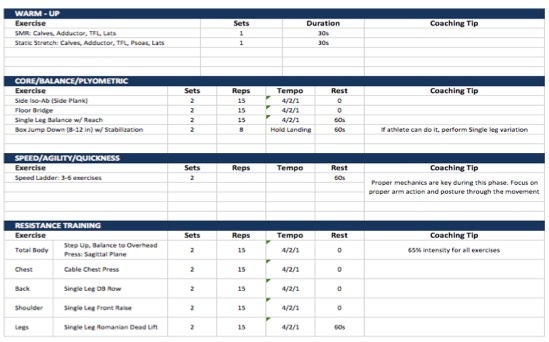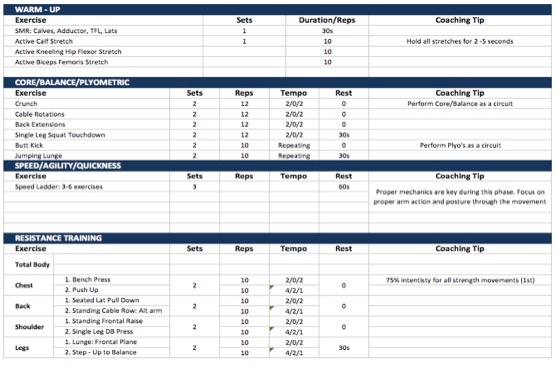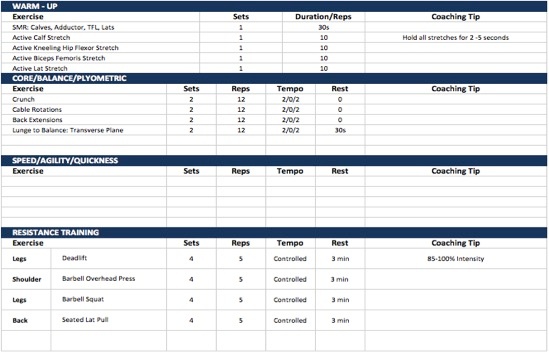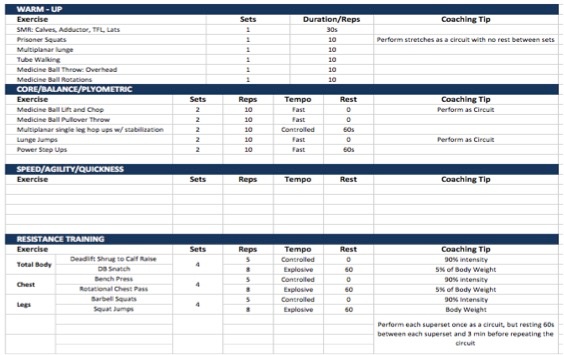A powerful vertical jump is often considered the epitome of athleticism. Many sports, such as basketball, volleyball, and some track and field events, require the athlete to perform at high levels in this movement [1].
However, many athletes find themselves overtraining or dedicating long hours in the gym and not seeing the result they desire [2]. A good vertical jump doesn't require exotic footwear, decades of training, or “freak genetics” (though that would be nice). By implementing the progressive, science-based Optimum Performance Training ™ (OPT™) model into the training program, some major hang time can be added in just weeks.
- LETS START WITH THE SCIENCE
Vertical jump performance is dictated by the Integrated Performance Paradigm, which states that precise movements rely on the body’s ability to eccentrically load, isometrically stabilize (transition), and concentrically accelerate force (these are collectively known as the muscle action spectrum) [3, 4]. Therefore, the performance of the vertical jump is directly reliant on the athlete’s ability to progress through these phases of movement with maximum force at the fastest rate with optimal neuromuscular coordination. Let’s discuss these concepts briefly:
The Three Phases of Reactive Movements
There are three distinct phases that collectively are known as the muscle action spectrum (MAS); eccentric phase, transition phase (amortization phase), and concentric phase [3]. The eccentric phase “loads” the action by pre-stretching the muscle and increasing muscle spindle activity. The potential energy developed is then stored in the elastic components of the muscle, ready to be fired. The transition phase is the time between the eccentric “loading” and the concentric “unloading” phase. The shorter the transition, the more powerful the action will be. Finally, the concentric phase “unloads” the stored and transferred potential energy from the previous phases [5].
You can learn more about the three phases and how to incorporate plyometric jumpes within this NASM blog on plyometrics.
Neuromuscular Coordination
Neuromuscular coordination refers to the ability of the nervous system to allow agonists, antagonists, synergists, and stabilizers to work interdependently during dynamic, athletic movement [3]. Neuromuscular coordination of muscle action directly affects the speed of muscular exertions. This means that the body will move only as fast as the nervous system has been programmed to move. Improper neuromuscular coordination will not allow the muscles to optimally transition through the full muscle action spectrum, ultimately inhibiting performance [6].
The “Formula”
We now have a formula to maximize our vertical jump:
Vertical Jump Enhancement = Maximal Force Production + Maximal Speed Through MAS + Maximal Neuromuscular Coordination
- THE BREAKDOWN
Let’s break down the formula to see how we can improve the individual sections.
Maximal Force Production
Strength is the measure of force production [2]. Strength is defined as the neuromuscular system’s ability to produce internal tension in the muscle to overcome an external load [3]. This concept is important to understand, as strength is not a function of the muscle, but rather a function of the activation of the neuromuscular system.
Utilizing heavier external loads increases the neural demand by recruiting more muscle fibers to overcome the load [4]. Strength, however, is built on the foundation of stabilization. If the tendons, ligaments, and muscles cannot handle the load, plateau or injury may result.
To summarize, as we gain strength, our nervous system gets better at recruiting muscle fibers and motor units [1]. In order to produce more force we need to lift heavier weights!
Maximal Speed Through MAS
The speed of muscular contraction is regulated by the neuromuscular system; regardless of how much force the muscle can produce (see strength from above section) [3]. To enhance the speed, the “load” and “transition” phases must be developed. The faster the eccentric loading, the stronger the force produced in the concentric phase. A prolonged transition phase will “leak” stored potential energy, resulting in a less-than-optimal concentric response [2]. In order to maximize speed we need to develop faster “loading” and “transition”!
Maximal Muscle Coordination
Performance is improved when muscles work together. With proper length-tension relationships, muscle groups are activated in the appropriate force couples which produce optimal movement patterns [6]. As these patterns evolve, appropriate stabilization of joints and connective tissues will ensure that the muscles can withstand the training load and limit injury [3, 4]. Appropriate length tension relationships, force couple relationships, and stabilization of muscles and connective tissues will ensure optimal muscle coordination and reduce risk of injury.
- Program Example
Here is an example of a 12-week program designed to improve the vertical jump.
(The program will include Phase 1, 2, 4 and 5 of the OPT model. Phase 3 (Muscular Development) is not included in this plan because it is not related to the goal.)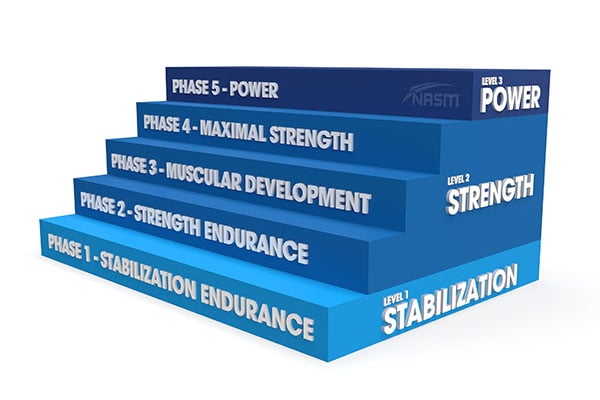
Phase 1: Develop Stabilization (3 weeks, 3x per week)
Objective: Developing maximal muscular coordination
Phase 2: Prepare Strength (3 weeks duration, 3x per week)
Objective: Enhance force production, prep athlete for Phase 4
Phase 4: Develop Strength (3 weeks, 3x per week)
Objectives: Develop maximal force production
Phase 5: Maximize Rate of Force Production (3 weeks, 3x per week)
Objective: Maximize speed through MAS (rate of force production)
- Vanrenterghem, J., et al., Performing the vertical jump: Movement adaptations for submaximal jumping. Human Movement Science, 2004. 22(6): p. 713-727.
- Henry, G.J., et al., Relationships between reactive agility movement time and unilateral vertical, horizontal, and lateral jumps. Journal of Strength & Conditioning Research (Lippincott Williams & Wilkins), 2016. 30(9): p. 2514-2521.
- National Academy of Sports Medicine. NASM Essentials of Sports Performance Training, 2nd ed. 2019.
- National Academy of Sports Medicine. NASM Essentials of Personal Fitness Training, 6th ed. 2018.
- Innocenti, B.F., Duccio and S. Torti, Analysis of biomechanical quantities during a squat jump: evaluation of a performance index. 2006.
- National Academy of Sports Medicine. NASM Essentials of Corrective Exercise Training. 2014.


